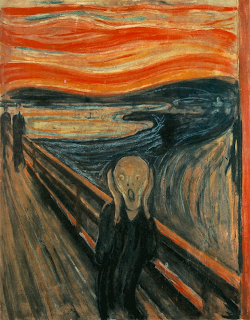** Note: I am not a doctor or medical expert. You should always check with your doctor before trying any treatment.**
"Menstrual migraine is generally severe, lasts longer, recurs more frequently, results in greater disability and is more resistant to therapy than nonmenstrual migraine." -SD Silberstein and J Goldberg in Journal of Reproductive Medicine 2007 Oct; 52(10):888-95.
If this is you, read on. [Updated 6/18/2009]
In my previous ode to the avocado, I noted it as a good source of magnesium. This may seem an obscure reference — that's not usually the thing one associates with avocados. Let me explain.

A. Me, during horridly horrible migraines at regular monthly intervals. Thank you, Mother Nature.
A migraine sufferer, one might assume that I have devoted much time researching this condition, and one would be absolutely correct. I did not want to take a prescription medication to deal with the migraines, offered a little too quickly by doctors. Over-the-counter pain killers didn't work well (I have tried them all at one point or another), and avoiding triggers like red wine helped but did not prevent my migraines. For a very long time, all of my adult life actually, I resigned myself to lying still in a dark and quiet room, usually until the next morning. This was fine, until I had children and couldn't temporarily drop all motherly duties. "There has got to be a better way," I kept telling myself, as I tried each new natural remedy and browsed the scientific literature. There is.
I have been migraine-free (and virtually headache-free) for nearly a year now, thanks to magnesium (Mg) and vitamin B-2 (riboflavin). This has worked for me and it might help others, too — but let me stress again that I am not a doctor, not all of this information is accepted medical practice, and may not work for every individual.
There are a few clinical researchers looking at the role of magnesium in the pathogenesis of migraines. Briefly, it is thought that some individuals naturally have lowered levels of ionized magnesium (the active form that is able to bind easily to proteins and other substances), a situation which may cause them to suffer migraines and which may also be remedied through dietary intake. Although the National Migraine Association cites the medical community's mixed support for magnesium, it nonetheless says taking the 100% RDA of Mg is probably a "safe and prudent" preventive. If you would like to geek out with the research — hey, I did and there is nothing wrong with that — knock yourself out here, here, here, here, here, and here (all link to the abstracts of published papers on PubMed).
Then I stumbled upon Mauskop and Fox's book in my search for The Miracle of Magnesium, and after a lengthy perusal of its contents at the local bookstore while deciding whether to buy it, I was convinced it couldn't hurt to try the remedy of Mg + riboflavin + feverfew favored by the authors. I figured I'd try this because in the off chance it worked for me, it would be worth avoiding a prescription drug and any associated side effects. And as long as I stayed within the recommended daily allowances (RDA), I couldn't see a downside. This would be the best decision related to treating my headaches I have ever made.

B. This is me now. Really.
According to the U.S. National Institutes of Health office of dietary supplements, Mg is essential for more than 300 biochemical reactions in the body, helping to maintain normal muscle and nerve function, blood pressure, heart rhythym, a healthy immune system, strong bones and more. A lack of energy may also be associated with low levels of Mg.
A few other bits of info you should know before trying this for yourself: The U.S. recommended daily allowances for Mg and riboflavin vary depending on your age and gender (for women aged 31-50 it is 320 mg and 1.1 mg, respectively). As with any vitamin and mineral, it is possible to have too much of a good thing. Hence the RDAs.
My own headache/migraine prevention regimen includes:
- Calcium-magnesium supplement containing 300-400 mg of Mg every other day
- Daily multivitamin that contains the max for riboflavin and low to no Mg
- Drink lots of water, eat a balanced diet, exercise, and avoid any known triggers
- Magnesium-rich foods (pumpkin seeds, spinach, soybeans, Alaskan salmon and halibut, black beans, avocados) during times when I know I'm prone to getting headaches.
While my migraines have ceased, I continue to get headaches although not as regularly and not as severe. I feel it worth repeating my previous admonition to talk to your doctor before trying this or any other new regimen for yourself.

No comments:
Post a Comment